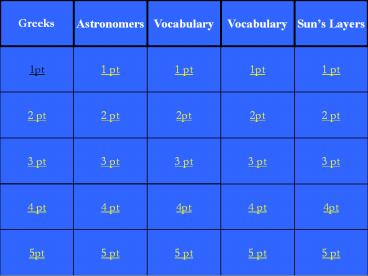Blank Jeopardy - PowerPoint PPT Presentation
Title:
Blank Jeopardy
Description:
Title: Blank Jeopardy Author: Eleanor M. Savko Last modified by: Sigle, Kristine Created Date: 8/19/1998 5:45:48 PM Document presentation format: On-screen Show (4:3) – PowerPoint PPT presentation
Number of Views:320
Avg rating:3.0/5.0
Title: Blank Jeopardy
1
Greeks
Astronomers
Vocabulary
Vocabulary
Suns Layers
1 pt
1 pt
1pt
1 pt
1pt
2 pt
2 pt
2pt
2pt
2 pt
3 pt
3 pt
3 pt
3 pt
3 pt
4 pt
4 pt
4pt
4 pt
4pt
5pt
5 pt
5 pt
5 pt
5 pt
2
- The ancient Greeks knew
- of all of the following planets
- EXCEPT
- Earth
- Saturn
- Uranus
- Venus
3
C. Uranus
4
Most ancient astronomers thought that all
celestial objects revolved around_______.
5
earth
6
An earth centered model of the universe is called
a _____________ model.
7
geocentric
8
Who developed this model?
9
Ptolemy
10
What name did the ancient Greeks give to the
wandering stars or wanderers
11
Planets
12
Who discovered that the planets orbit is an
ellipse?
13
Kepler
14
Who explained that the sun is at the center of
the universe, but lacked evidence?
15
Copernicus
16
He made observations to support the heliocentric
system
17
Galileo
18
He made careful observations of the planets
orbits
19
Brahe
20
He was one of the first to use a telescope to
observe the solar system from earth.
21
Galileo
22
How does the sun produce energy?
23
Nuclear Fusion
24
The layer of the suns atmosphere that we see
25
Photosphere
26
A stream of electrically charged particles coming
from the corona
27
Solar wind
28
The two layers of the suns atmosphere that we
see during a solar eclipse
29
Chromosphere and corona
30
The middle layer of the suns atmosphere
31
chromosphere
32
This layer of the suns atmosphere looks like a
halo
33
corona
34
Eruptions on the sun
35
Solar flares
36
This includes the sun, planets, moon and several
smaller objects.
37
Solar system
38
These are areas of gas on the sun that are cooler
then the surrounding areas.
39
Sunspots
40
The red layer around the sun at that beginning
and end of a solar eclipse
41
Chromosphere
42
Name and describe A
43
A is the corona. It is a white halo that can only
be seen at the middle of a total solar eclipse.
44
Name and describe D
45
D are sunspots. They are areas of gas on the sun
that are cooler than the surrounding gasses.
46
Name and describe E
47
E is a prominence. It is a reddish loop of gas
that connects sunspot regions.
48
Name and describe C
49
C is the photosphere. It is the light layer that
we see from Earth.
50
Name and describe F
51
F is the core. It is the center of the sun where
nuclear fusion occurs.































